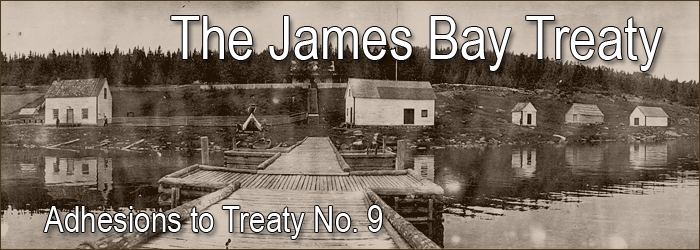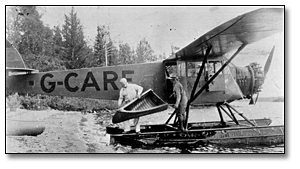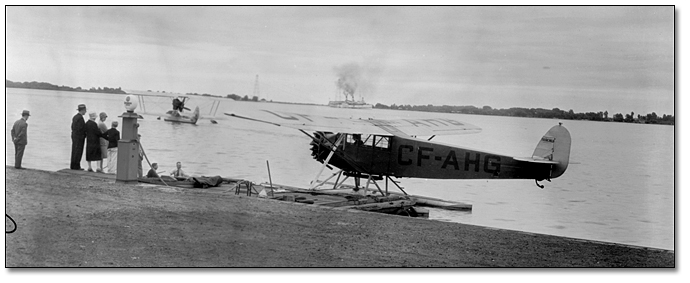
Table of Contents
Home | Peoples and Events Shaping Treaty No.9 | The Treaty No.9 Expedition of 1905-1906Developing the Treaty Relationship, 1905-2005 | The James Bay Treaty - Treaty No.9
Adhesions to Treaty No. 9 | 2013 Mushkegowuk Council Conference | About the Title Images
Once the James Bay Treaty had dealt with the lands south of the Albany River, the First Nations Peoples north of the River saw the newfound status awarded to their southern relatives and began to petition for recognition of their bands. Many expected the Treaty to be quickly extended north of the Albany River, then known as the Patricia Portion, especially when the Ontario Boundaries Extension Act of 1912 transferred the area to the province and the Federal Government extended the Ontario-Quebec boundary to Hudson Bay the same year.
After several postponements, Ontario agreed to “adhere” this unceded territory and planned a second two-year signing tour for the summers of 1929-1930. Herbert Nathaniel Awrey of the Department of Indian Affairs, was appointed as the federal commissioner with Walter Charles Cain, Ontario’s Deputy Minister of Lands and Forests, as the provincial commissioner.
The contrasts between the “Adhesions” Tours and those of 23 years earlier were striking. Rather than using Hudson's Bay Company canoes and months of portaging before winter, Commissioners Awrey and Cain used airplanes, despite the problem of transporting enough aviation fuel by steamship through the Hudson Strait, to sites along the shores of Hudson Bay and James Bay.

Click to see a larger image
Sectional canoe being unloaded
from an airplane, [ca. 1925]
Ministry of Education
Black and white print
Reference Code: RG 2-71 WM-53
Archives of Ontario, I0004308
In 1929, Cain requisitioned one of his government’s Provincial Air Service’s Gypsy Moth aircraft, while Awrey, with physician Dr. G.W. Bell of Sioux Lookout, used a new Royal Canadian Air Force Fairchild 71-C monoplane. In 1930, fighting forest fires required the use of every provincial aircraft so the Department of National Defense provided two Fairchild aircraft, along with the military pilots and mechanics. Bad weather, non-existent radio communication, and the danger of becoming lost in a land without navigational aids forced both planes to maintain visual contact while leap-frogging between the signing locations at Big Trout Lake (5 July 1929), Wendigo River at Nikip Lake (17 July 1930), Trout Lake (18 July 1930), Fort Severn (25 July 1930), and Winisk (28 July 1930).

Click to see a larger image
Airplane refuelling station, [ca. 1925]
Ministry of Education
Black and white print
Reference Code: RG 2-71 VA-3
Archives of Ontario, I0004268
With the 1929-1930 “Adhesion” signings, the James Bay Treaty ceded more than two-thirds of the province to the Ontario government and permitted the development of its timber, mineral, and hydroelectric resources. The development of the northland is still a “work in progress” as the Cree and Ojibway communities preserve their traditional values and way of life, while striving to give their children the vision and tools needed to prosper in the second century of the James Bay Treaty.
![James Bay Treaty (Treaty No. 9) [page 1]](pics/adhesions-cover-300b.jpg)
Click to see a larger image
James Bay Treaty (Treaty No. 9) Adhesions
Reference Code: RG 1-653
(Articles of James Bay Treaty (Treaty No. 9))
Archives of Ontario
![James Bay Treaty (Treaty No. 9) [page 1]](pics/adhesions-inside-cover-300.jpg)
Click to see a larger image
James Bay Treaty (Treaty No. 9) [title page]
Reference Code: RG 1-653
(Articles of James Bay Treaty (Treaty No. 9))
Archives of Ontario
A text version of the James Bay Treaty (Treaty No. 9) is available on the Indian Northern Affairs Canada website.
![James Bay Treaty (Treaty No. 9) [page 3]](pics/adhesions-page1-160.jpg)
![James Bay Treaty (Treaty No. 9) [page 5]](pics/adhesions-page2-180.jpg)
![James Bay Treaty (Treaty No. 9) [page 4]](pics/adhesions-page3-180.jpg)
![James Bay Treaty (Treaty No. 9) [page 4]](pics/adhesions-page4-180.jpg)
![James Bay Treaty (Treaty No. 9) [page 6]](pics/adhesions-page5-180.jpg)
![James Bay Treaty (Treaty No. 9) [page 7]](pics/adhesions-page6-180.jpg)